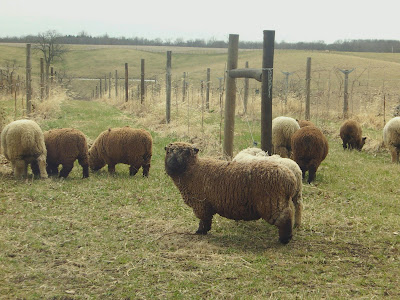


We picked up our new Jeep Wrangler today. Here are a few pictures...
The Adventures of a Florida Girl Growing Winegrapes in Iowa








 No, that is not a tropical disease, it's what is currently sitting in my garage. Greg and I (okay, mostly Greg) got all of the beehive boxes primed and painted this weekend. The boxes need one more coat of paint and then they'll be done. We still have about 140 frames to assemble. These go inside the boxes and hold the foundation that provides a starting point for the bees to build out the comb. Each hive box holds ten frames. This step should go pretty fast with the pneumatic stapler Greg picked up at Menard's on Saturday, and the jig I borrowed from a member of the Beekeeping Club, which allows you to put ten frames together in a batch and holds them in place while you staple the pieces together. Once that is done, I'll need to find the perfect location for the hives, and set up some cinder blocks and pallets in an area with full sun and good air circulation. Ideally, the location needs to be at a relatively high elevation which helps keep the hives from getting too humid inside, which promotes diseases. Also the hives need to be in full sun so they warm up in the morning as early as possible, which encourages the bees to get out and forage for nectar and pollen. The more hours per day the population is active and working, the more honey gets made. The site also needs to be accessible to me year round, and I need to be able to drive up pretty close so that I can take off the honey supers when it's time to harvest the honey in September. I need to be able to check on them several times in the winter as well, and add sugar syrup if the stored honey is running low. I plan to put some sort of fence around the hives to keep wildlife, especially skunks, away from them. Fortunately we don't have bears in Southern Iowa.
No, that is not a tropical disease, it's what is currently sitting in my garage. Greg and I (okay, mostly Greg) got all of the beehive boxes primed and painted this weekend. The boxes need one more coat of paint and then they'll be done. We still have about 140 frames to assemble. These go inside the boxes and hold the foundation that provides a starting point for the bees to build out the comb. Each hive box holds ten frames. This step should go pretty fast with the pneumatic stapler Greg picked up at Menard's on Saturday, and the jig I borrowed from a member of the Beekeeping Club, which allows you to put ten frames together in a batch and holds them in place while you staple the pieces together. Once that is done, I'll need to find the perfect location for the hives, and set up some cinder blocks and pallets in an area with full sun and good air circulation. Ideally, the location needs to be at a relatively high elevation which helps keep the hives from getting too humid inside, which promotes diseases. Also the hives need to be in full sun so they warm up in the morning as early as possible, which encourages the bees to get out and forage for nectar and pollen. The more hours per day the population is active and working, the more honey gets made. The site also needs to be accessible to me year round, and I need to be able to drive up pretty close so that I can take off the honey supers when it's time to harvest the honey in September. I need to be able to check on them several times in the winter as well, and add sugar syrup if the stored honey is running low. I plan to put some sort of fence around the hives to keep wildlife, especially skunks, away from them. Fortunately we don't have bears in Southern Iowa.  Here's what carnage looks like...
Here's what carnage looks like...

